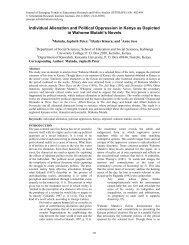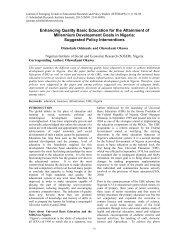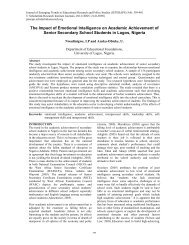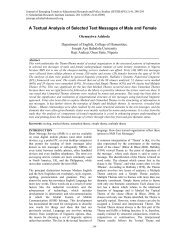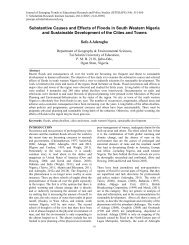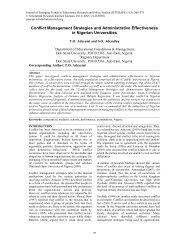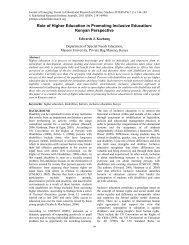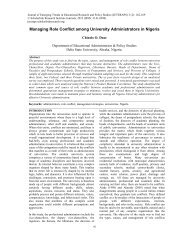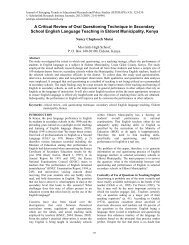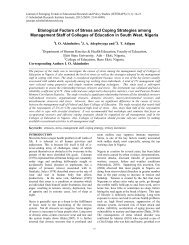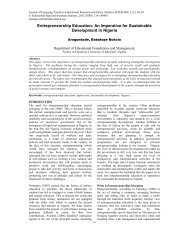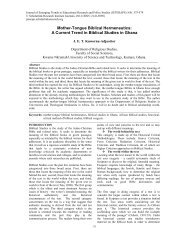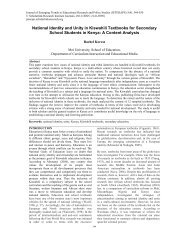Performance of Senior Secondary School Science Students in ...
Performance of Senior Secondary School Science Students in ...
Performance of Senior Secondary School Science Students in ...
Create successful ePaper yourself
Turn your PDF publications into a flip-book with our unique Google optimized e-Paper software.
Journal <strong>of</strong> Emerg<strong>in</strong>g Trends <strong>in</strong> Educational Research and Policy Studies (JETERAPS) 2(6):431-435 (ISSN:2141-6990)<br />
measures general mental ability demand<strong>in</strong>g<br />
application <strong>of</strong> knowledge <strong>in</strong> verbal and non-verbal<br />
doma<strong>in</strong>s. It is easily <strong>in</strong>fluenced by present and past<br />
environment <strong>of</strong> the candidate. Ak<strong>in</strong>boye (2001) gave<br />
the Raven’s progressive matrices, which measures<br />
general <strong>in</strong>telligence as an example <strong>of</strong> such test.<br />
Numerical ability tests are designed to measure the<br />
candidates’ capacity to manipulate or use numbers to<br />
correctly solve problems (Ann, 2004). Such tests<br />
signify basic arithmetic prowess <strong>in</strong> an <strong>in</strong>dividual.<br />
Accord<strong>in</strong>g to Nunnally (2004), it is the ability to<br />
relatively solve problems <strong>in</strong> number sequenc<strong>in</strong>g,<br />
make accurate mathematical deductions through<br />
advanced numerical reason<strong>in</strong>g, <strong>in</strong>terpret complex<br />
data presented <strong>in</strong> various graphical forms, deduce<br />
<strong>in</strong>formation and draw logical conclusions. All forms<br />
<strong>of</strong> school exam<strong>in</strong>ations <strong>in</strong> various subjects, are also<br />
broadly speak<strong>in</strong>g types <strong>of</strong> achievement test <strong>of</strong> which<br />
numerical ability test is one, It can be given directly<br />
to candidates or adm<strong>in</strong>istered as subsets <strong>of</strong> other<br />
tests. Similarly, verbal ability tests are tests used to<br />
deduce the ability <strong>of</strong> an <strong>in</strong>dividual to reason with<br />
words (Ak<strong>in</strong>boye, 2001). They <strong>in</strong>dicate the acquired<br />
capability for comprehension and communication <strong>in</strong><br />
an <strong>of</strong>ficial medium like English Language. This will<br />
require oral or written mode <strong>of</strong> response as the case<br />
may require.<br />
Aptitude tests measure the <strong>in</strong>nate, acquired or<br />
developed component <strong>of</strong> competency <strong>in</strong> knowledge,<br />
understand<strong>in</strong>g and attitude used <strong>in</strong> do<strong>in</strong>g certa<strong>in</strong> k<strong>in</strong>d<br />
<strong>of</strong> work at a particular level (Toplis, 1991). Aptitude<br />
may be physical or mental; the <strong>in</strong>nate nature <strong>of</strong><br />
aptitude is <strong>in</strong> contrast to achievement, which<br />
represents knowledge that is ga<strong>in</strong>ed through learn<strong>in</strong>g<br />
(Carr, 2004). Aptitude breaks mental ability down<br />
<strong>in</strong>to different characteristics, which are supposed to<br />
be more or less <strong>in</strong>dependent <strong>of</strong> each other; it is<br />
forward look<strong>in</strong>g as it predicts the potential for future<br />
ability to learn a skill or set <strong>of</strong> skills <strong>in</strong> a candidate.<br />
Aptitude confirms present abilities and potentials to<br />
learn and cope with new situations <strong>in</strong> the future. The<br />
difference between aptitude test and achievement test<br />
(which <strong>in</strong>clude numerical and verbal ability tests) is<br />
majorly that, while aptitude test outcomes are used as<br />
predictors <strong>of</strong> future performance, on the other hand,<br />
achievement tests are only ‘revealers’ <strong>of</strong> present<br />
performance after learn<strong>in</strong>g.<br />
Compared to achievement tests, aptitude tests cover a<br />
broader area and look at other range <strong>of</strong> experiences.<br />
Achievement tests are closely tied to particular<br />
school subjects. Aptitude tests tell us what a student<br />
br<strong>in</strong>gs to the task regardless <strong>of</strong> the specific<br />
curriculum that the student has already experienced.<br />
The difference between aptitude test and achievement<br />
tests is sometimes a matter <strong>of</strong> degree, some aptitude<br />
and achievement tests look a lot alike. Generally all<br />
tests are used for the follow<strong>in</strong>g purpose; selection,<br />
admission and certification.<br />
If the student scores <strong>in</strong> verbal and numerical ability<br />
tests significantly predict the score <strong>in</strong> aptitude test, it<br />
then means that verbal and numerical ability tests can<br />
be validated us<strong>in</strong>g a good aptitude test. This will be a<br />
significant contribution <strong>of</strong> this study to knowledge<br />
apart from provid<strong>in</strong>g empirically-based suggestion<br />
for students to develop high verbal and numerical<br />
skills <strong>in</strong> order to do well <strong>in</strong> aptitude test.<br />
Research Questions<br />
The follow<strong>in</strong>g research questions are answered <strong>in</strong> this<br />
study:<br />
1. What is the comb<strong>in</strong>ed <strong>in</strong>fluence <strong>of</strong> numerical and<br />
verbal abilities on student performance <strong>in</strong> the<br />
general aptitude test?<br />
2. What is the relative <strong>in</strong>fluence <strong>of</strong> students’ verbal<br />
ability on their performance <strong>in</strong> the general aptitude<br />
test?<br />
3. What is the relative <strong>in</strong>fluence <strong>of</strong> students’<br />
numerical ability on their performance <strong>in</strong> the general<br />
aptitude test?<br />
4. What are the relationships among students’<br />
performances <strong>in</strong> general aptitude, verbal and<br />
numerical ability tests?<br />
5. Is there any significant difference between male<br />
and female students’ performance <strong>in</strong> (i) verbal ability<br />
(ii) numerical ability and (iii) general aptitude?<br />
METHODOLOGY<br />
Design, Sampl<strong>in</strong>g Technique and Sample<br />
The design used for this research was descriptive<br />
survey. This is because data were collected on a<br />
sample <strong>of</strong> respondents, which are representative <strong>of</strong><br />
the target population. As such, the f<strong>in</strong>d<strong>in</strong>gs can be<br />
generalized on the whole population. The target<br />
population for this study was the senior secondary<br />
school science students <strong>in</strong> Ijebu Area <strong>of</strong> Ogun State,<br />
Nigeria. Five senior secondary schools were<br />
randomly selected from Ijebu Area. In each school,<br />
forty science students selected through random<br />
sampl<strong>in</strong>g participated <strong>in</strong> the study. Thus, the sample<br />
size for the study is 200. The sample comprised one<br />
hundred male and one hundred female students<br />
selected from the senior secondary II level <strong>in</strong> all the<br />
schools. The average age <strong>of</strong> students is 16.5 years.<br />
Research Instruments<br />
The <strong>in</strong>struments used were developed by the<br />
researchers. They are: Numerical Ability Test (NAT),<br />
Verbal Ability Test (VAT) and General Aptitude Test<br />
(GAT). Each <strong>of</strong> NAT, VAT and GAT conta<strong>in</strong>s thirty<br />
items. The <strong>in</strong>struments were given to experts for<br />
comments and suggestions before the f<strong>in</strong>al version<br />
was adm<strong>in</strong>istered on the respondents. The test retest<br />
reliability coefficients for NAT, VAT and GAT are<br />
0.712, 0.722 and 0.699 respectively.<br />
432



